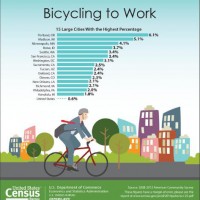Census Bureau: Bicycle commuting on the rise
Many U.S. cities are seeing an increase in bicycle commuters, according to a U.S. Census Bureau report released this week.
Nationwide, the number of people who traveled to work by bike increased roughly 60 percent over the last decade, from about 488,000 in 2000 to about 786,000 during the 2008-2012 period. This is the largest percentage increase of all commuting modes tracked by the 2000 Census and the 2008-2012 American Community Survey.
The Census Bureau also released a new commuting edition of the interactive map Census Explorer, which gives Web visitors easy click-and-zoom access to commuting statistics for every neighborhood in the U.S. It also shows how commuting has changed since 1990 at the neighborhood, county and state level — including how long it takes to get to work, commutes longer than an hour, and number of bikers. This edition of Census Explorer uses statistics from the American Community Survey, the best national source of commuting statistics down to the neighborhood level.
"In recent years, many communities have taken steps to support more transportation options, such as bicycling and walking," said Brian McKenzie, a Census Bureau sociologist and the report's author. "For example, many cities have invested in bike share programs, bike lanes and more pedestrian-friendly streets."
While bicyclists still account for just 0.6 percent of all commuters, some of the nation's largest cities have more than doubled their rates since 2000. Portland, Ore., had the highest bicycle-commuting rate at 6.1 percent, up from 1.8 percent in 2000. In Minneapolis, the rate increased from 1.9 percent to 4.1 percent.
The report also looks at the number of people who walk to work. After steadily decreasing since 1980, the percent of people who walk to work has stabilized since 2000. In 1980, 5.6 percent of workers walked to work, and that rate declined to 2.9 percent by 2000. However, in the 2008-2012 period, the rate of walkers remained statistically unchanged from 2000. Among larger cities, Boston had the highest rate of walking to work at 15.1 percent.
The report, "Modes Less Traveled — Bicycling and Walking to Work in the United States: 2008-2012," highlights the trends and socio-economic and geographic differences between motorized and nonmotorized commutes. This report — the Census Bureau's first focusing only on biking and walking to work — is one of many that examines specific aspects of commuting, including workplace location, working from home, long commutes and specific travel modes.
Biking to Work Highlights
- The West had the highest rate of biking to work at 1.1 percent, and the South had the lowest rate at 0.3 percent.
- Among large cities, Portland, Ore., had the highest bicycle-commuting rate at 6.1 percent.
- The median commute time for those who bike to work was about 19.3 minutes.
- Men were more likely than women to bike to work. The rate of bicycle commuting for men was more than double that of women, 0.8 percent compared with 0.3 percent.
- Those with a graduate or professional degree or higher and those with less than a high school degree had the highest rates of biking to work, at 0.9 and 0.7 percent, respectively.
- 1.5 percent of those with an income of $10,000 or less commuted to work by bicycle, the highest rate of bicycle commuting by any income category.
- African-Americans had the lowest rate of biking to work at 0.3 percent, compared with some other race or two or more races who had the highest rate at 0.8 percent.
Walking to Work Highlights
- The Northeast showed the highest rate of walking to work at 4.7 percent of workers. Several of the places with high rates were "college towns," including Ithaca, N.Y., where about 42.4 percent walked to work. The South had the lowest rate at 1.8 percent. Among large cities, Boston was one of the highest walking-to-work cities at 15.1 percent.
- Workers living in core cities walked to work at a rate of 4.3 percent, compared with 2.4 percent for workers in suburbs.
- The median commute time for those who walk to work was 11.5 minutes, and they left their home at later hours than other modes.
- Men walked to work at a rate of 2.9 percent compared with 2.8 percent for women.
- Those with less than a high school degree had the highest rate of walking to work at 3.7 percent, followed by those with graduate or professional degrees at 2.7 percent.
- 8.2 percent of those with an income of $10,000 or less walked to work, the highest rate of walking to work by any income category.
- Asians and workers of some other race or two or more races had the highest rate of walking to work at 4.0 and 4.2, respectively.
About the American Community Survey
The figures in this release come from data collected from questions in the Census Bureau's 2008-2012 American Community Survey. The questions asked include:
- How did this person usually get to work last week? If this person usually used more than one method of transportation during the trip, mark (X) the box of the one used for most of the distance.
- How many people, including this person, usually rode to work in the car, truck, or van last week?
- What time did this person usually leave home to go to work last week?
- How many minutes did it usually take this person to get from home to work last week?
Organizations use the statistics from this question to design programs that ease traffic problems, reduce congestion and promote carpooling. In addition, police and fire departments use the statistics to plan for emergency services in areas where many people work. The American Community Survey provides local statistics on a variety of topics for even the smallest communities.
For more information, visit http://www.census.gov/acs/www/data_documentation/documentation_main/.


